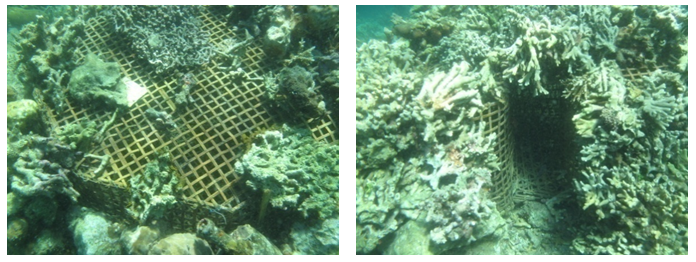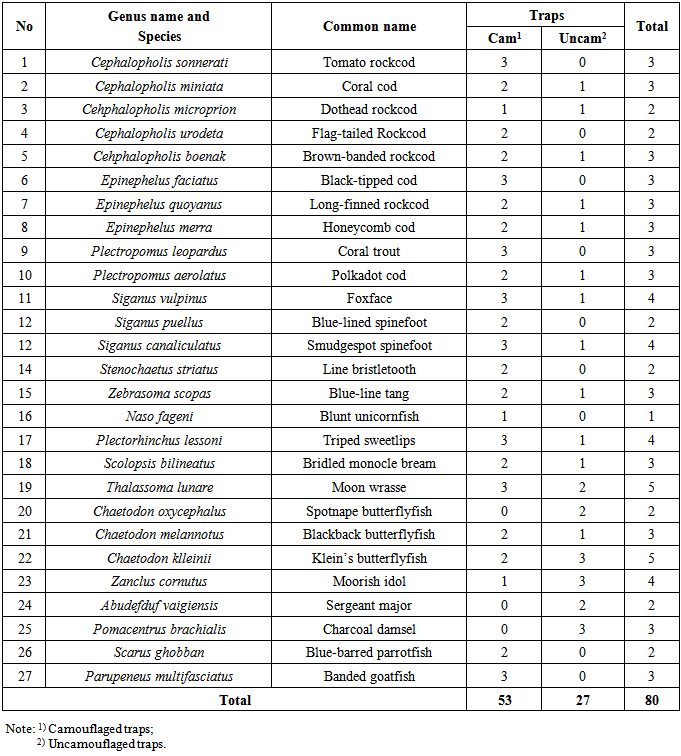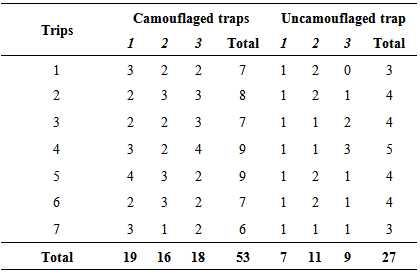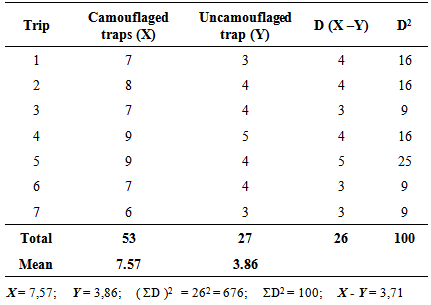-
Paper Information
- Paper Submission
-
Journal Information
- About This Journal
- Editorial Board
- Current Issue
- Archive
- Author Guidelines
- Contact Us
International Journal of Ecosystem
p-ISSN: 2165-8889 e-ISSN: 2165-8919
2015; 5(3): 80-84
doi:10.5923/j.ije.20150503.02
The Effect of Palm Fiber Camouflage on Trap for the Capture of Coral Fishes in Bangka Strait, North Sulawesi Indonesia
Emil Reppie
Faculty of Fisheries and Marine Science, Sam Ratulangi University Manado, Indonesia
Correspondence to: Emil Reppie, Faculty of Fisheries and Marine Science, Sam Ratulangi University Manado, Indonesia.
| Email: |  |
Copyright © 2015 Scientific & Academic Publishing. All Rights Reserved.
Bangka Strait, North Sulawesi, Indonesia, has fairly extensive coral reefs. Unfortunately, fishing practice of the traditional traps is usually conducted in destructive way, in which fishermen cover the gear with live corals deliberately broken as a shelter to attract fishing target. This research was aimed to study the effect of palm fiber camouflaged cover on trap to capture coral fishes, and identify the fish caught.This research was done in Bangka Strait, North Minahasa, in November- December 2014, based on experimental method. Six units of traps were operated during seven trips of data callection, where three traps were camouflaged with palm tree fibers, and the other three units without palm fibers. Catches were checked every 4 days, and data were analyzed by t test.The trap catches during the study were 80 fish in total, 53 fish were caught by palm fibers-camouflaged trap, and 27 fish without palm fibers. The t test showed that t0.05 = 4.914 > ttab meaning that the trap catch with palm fibers camouflaged is significantly different from that without palm fibers.
Keywords: Bangka Strait, Coral reef degradation, Camouflaged trap, Coral fishes
Cite this paper: Emil Reppie, The Effect of Palm Fiber Camouflage on Trap for the Capture of Coral Fishes in Bangka Strait, North Sulawesi Indonesia, International Journal of Ecosystem, Vol. 5 No. 3, 2015, pp. 80-84. doi: 10.5923/j.ije.20150503.02.
1. Introduction
- Marine environments are recently under enormous pressure, arising through anthropogenic causes, such as overfishing and environmental destruction. However, fisheries are able to recover or stabilize their populations when responsible management and regulations are implemented through the use of more sustainable method of fishing in fiheries exploitation [1].Bangka Strait in North Minahasa Regency of North Sulawesi, Indonesia, has fairly extensive coral reefs with various lifeforms. The strait is also used as a navigation channel by merchant and passenger ships in and out of Bitung Oceanic Port, the location of pearl farming, floating net fish farming, seaweed farming, shrimp pond, fishing areas of halfbeak (Hemiramphus sp.), the small pelagic fish used as live bait of pole and line fishing, as well as tourism activities based in Gangga Resort. Mangrove forest in this region is thought to be the largest in the mainland coast of Minahasa. Several locations in the coastal waters have been designated as marine protected areas.However, the development activities in the coastal areas in recent years have given various significantly negative impacts on the quality of the coral reef resources in Indonesia. Many studies reported that the quality of coral reefs in Indonesia is declining rapidly [2, 3], and only 29 percent of Indonesian coral reefs are in good to excellent conditions [4, 5, 2, 6, 3].Trap or fish pot is one of the common fishing gears used by fishermen in Bangka Strait to catch reef fish, since it is simple in construction, relatively inexpensive and easy to operate with a small boat. Unfortunately, the fishing practice of the traditional traps is usually conducted in destructive way, where fishermen cover the gear with live coral as a shelter to attract fishing target. When the traps are moved to another fishing location, the fishermen will use new live corals to cover the traps in these locations.The use of corals to camouflage the gear will damage the corals, while the alternative materials could be used without damaging the corals, such as palm fibers or coconut leaves that are easy to find on land. This research was aimed to study the effect of palm fiber camouflage on trap to catch coral fishes, and identify the type of fish caught.
 | Figure 1. Study site |
 | Figure 2. An example of trap settings that damages the environment |
2. Method
- This study was done in Bangka Strait North Minahasa in November- December 2014, based on experimental method. Traps used in this study were made of iron frame of 10 mm, with 120 cm long, 60 cm wide, and 50 cm high. The trap walls and entrances were made of PE net 380 D/12, two inches in mesh size. Six units of traps were operated during seven trips for data collection, in which three units were camouflaged with palm tree fibers and the other three units without palm fibers. All traps were operated without bait at the depth of about 7-10 m. Catches were checked every 4 days. Catch data were analyzed using t test [7], as follows:
 or
or 
3. Results and Discussion
- Catch and AnalysisThe catch of trap during the study was 80 fish in total consist of 2 genera; 53 fish was caught by palm fibers camouflaged trap, and 27 fish was caught by trap without camouflaged (Table 1). The types of fish are caught.The trap catch during the study consisted of 80 fish in total, belonging to 16 genera and 27 species, in which 53 fish were caught in palm fibers-camouflaged traps, and 27 fish in traps without palm fibers. Fish species caught are presented in Table 1.
|
|
|
4. Discussion
- Trap fishing gear has been very extensively used in the world, but the basic concept is the same in all cases, in which fish or other marine animals will enter into traps through one or more conical entrance [8]. The success of trap fishing gear is dependent on the behavior of marine animals as target of fishing. The gear size acts as a fishing function, where the marine animals can enter and escape [9].The fish response to the trap and its surrounding is done through smell and sight or eagerness to take refuge from predators. The use of the sense of smell in fish occurs in traps baited, while the sense of sight or sheltered occur in unbaited trap. Most traditional traps operated in Bangka Strait is without bait, and thus it needs to be camouflaged with coral to attract fish sheltering.The results provide information that camouflaged traps with other materials, such as palm fibers other than live corals, could also increase the catch. The amount of traps operated in Bangka Strait until 2014 was 65 units. Fishing locations of the traps were usually moved after 7 trips or about a month. The amount of coral cover needed to disguise traps per unit is about 1 sq.m. If it is assumed that 40 units of the traps can operate throughout the year (10 months), so the amount of coral damages in Bangka Strait could reach 400 sq m per year.The total average economic value of coral reefs in Indonesia represented by West Lombok is > US $ 1.0 / m2 [4]. Thus, the value of damaged coral reefs in the Bangka Strait is far greater than US $ 400/m2/year. In some countries, the value of compensation for damaging coral reefs from the ship accident or pollution is between $ 10-1000 / m2, such as Mexico, United States, Pacific and Egypt have established the average fine coral reef damage of US $ 1,000/m2 based on the restoration cost.Realizing this condition, efforts of all stakeholders are needed to minimize environmental damages from fishing operations of traditional traps and to ensure the sustainability of coastal community source of Bangka Strait.
5. Conclusions
- Trap fishing gear using palm fiber camouflage can obtain higher catches (66.25%) than that without palm fibers (33.75%). The types of fish caught consisted of 16 genera and 27 species and 76.25% dominated by the target species. Materials palm fibers can be used as an impostor pot to replace the habit of damaging corals in Bangka Strait.
 Abstract
Abstract Reference
Reference Full-Text PDF
Full-Text PDF Full-text HTML
Full-text HTML

